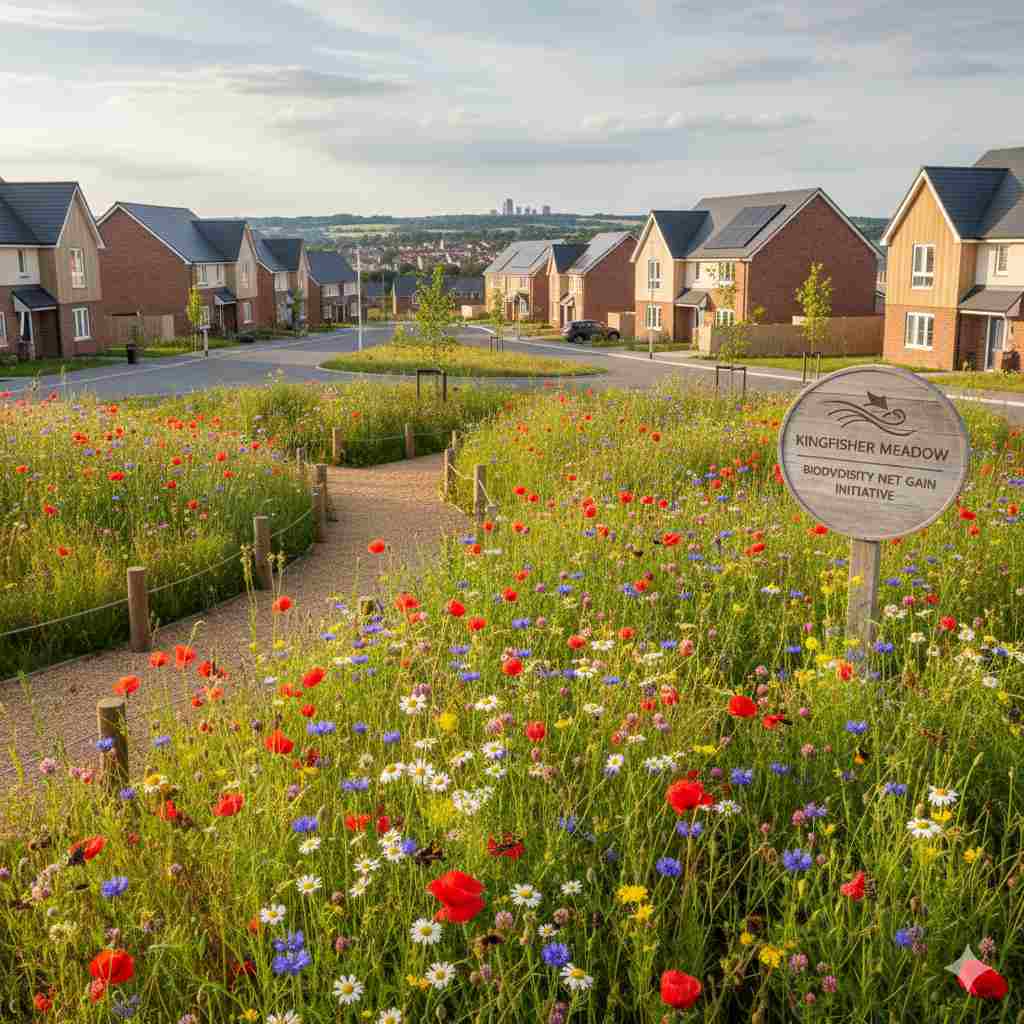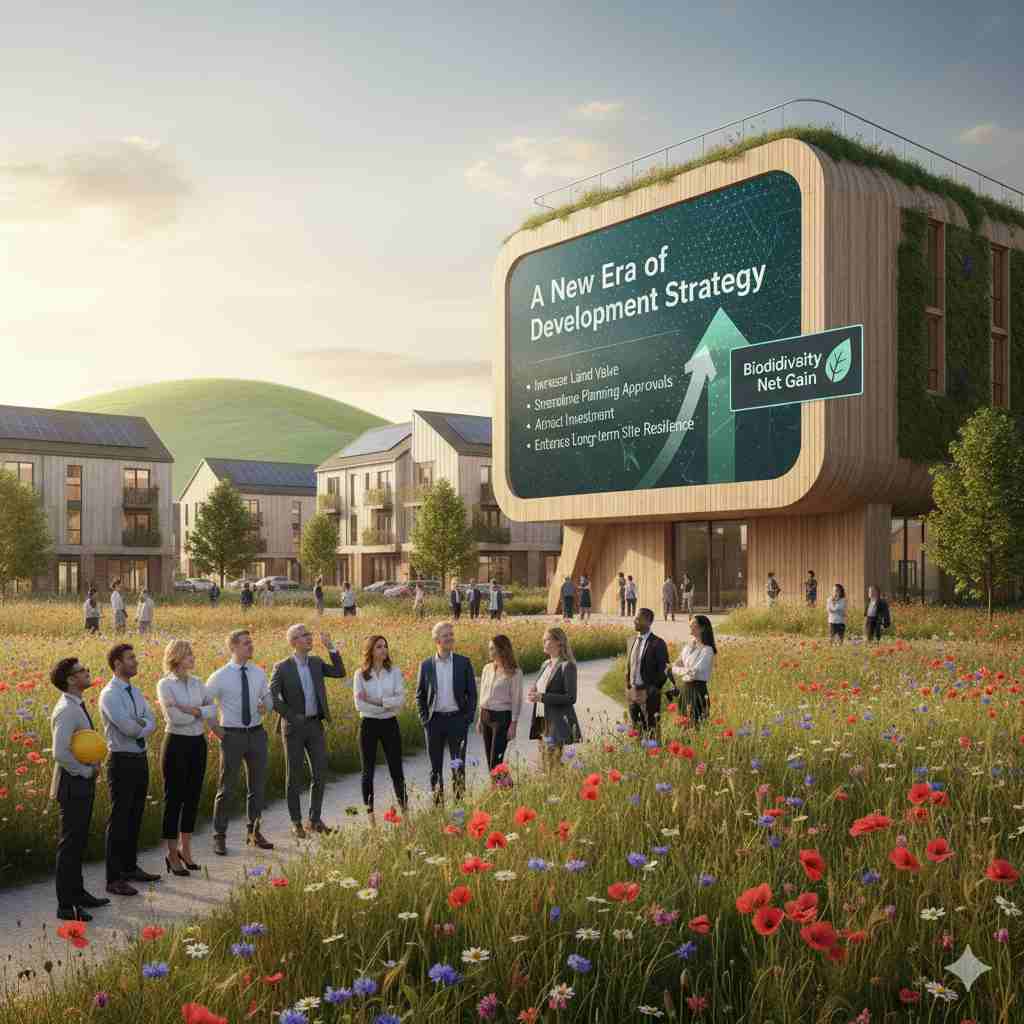From Obligation to Opportunity: Biodiversity Net Gain as a Strategic Asset for Land Developers
The BNG Paradigm Shift in Development
Biodiversity Net Gain (BNG) has become one of the most significant policy shifts in the UK’s land development landscape in decades. Mandated under the Environment Act 2021, BNG requires developers to leave habitats in a measurably better state than before development. As of February 2024, most major developments must achieve a net gain of at least 10% in biodiversity, calculated using the Defra Metric 4.0.
While this may sound like a regulatory burden, forward-thinking developers are already leveraging BNG as a strategic asset—enhancing project viability, streamlining planning approvals, and increasing long-term land value. This article explores how early integration of biodiversity planning transforms BNG from a legal hurdle into a competitive advantage.
BNG Compliance Across the Development Lifecycle
BNG compliance begins before the first spade hits the ground. To avoid costly retrofits or planning rejections, developers must integrate BNG principles across every stage of the project lifecycle.
1. Land Acquisition: Assessing Biodiversity Feasibility Early
Site selection now needs to factor in not just planning potential, but baseline ecological value. Using the statutory biodiversity metric tool, developers can calculate biodiversity units present on a site pre-development, assess uplift feasibility, and estimate potential costs or savings. Sites that offer space for high-distinctiveness habitat creation—without jeopardising commercial density—provide better long-term value.
2. Design and Planning: Building BNG into the Blueprint
Achieving the required biodiversity uplift often involves adjusting design parameters. This may mean reducing building footprint, integrating green infrastructure, or dedicating areas for wildflower meadows or ponds. Working with ecologists and landscape architects at this stage helps to align architectural vision with ecological compliance, improving the likelihood of planning approval and reducing late-stage delays.
3. Construction and Post-Handover: Managing Long-Term Liability
BNG isn’t just a tick-box for planning—developers are legally responsible for maintaining habitat gains for 30 years. This long-term liability must be managed through robust monitoring plans, covenants, or management agreements with third parties. A poorly planned post-handover strategy could expose firms to enforcement actions or reputational damage down the line.
Wildflower Meadows: A High-Return Habitat Strategy
Among the range of habitats available for BNG, species-rich wildflower meadows stand out as one
Why Wildflowers Work: High Units, Low Maintenance
Wildflower meadows are frequently classified as High or Very High distinctiveness habitats, earning significant biodiversity units per square metre. They also require minimal long-term maintenance—typically an annual cut and removal—making them ideal for developers managing 30-year liabilities.
Unlike complex habitats like woodlands or watercourses, which may require specialist intervention, meadows offer a simple, scalable solution.

Providers like Wildahome offer seed mats and tailored seed mixes that help developers meet specific habitat condition targets under Defra’s metric, ensuring compliance without ecological guesswork.
Visual Appeal and Market Value
Beyond compliance, wildflower spaces significantly enhance the visual and lifestyle appeal of developments. Buyers and tenants increasingly prioritise access to nature, and vibrant, pollinator-friendly landscapes can improve a neighbourhood’s perceived value—especially in mixed-use or residential schemes.
In competitive markets, these features can provide a sales differentiator, helping developers justify higher prices and faster absorption rates.
Strategic Cost Avoidance: Avoiding High-Penalty Habitats
BNG policy introduces substantial financial risk for developers who damage or remove habitats of high distinctiveness, particularly watercourses or ancient woodland. These habitats can cost upwards of £160,000 per biodiversity unit to offset through statutory credits—far more than private market rates.
The Mitigation Hierarchy in Action
The Environment Act enshrines the mitigation hierarchy: avoid → minimise → mitigate → compensate. Avoidance is not only the ecologically preferred strategy but also the most financially prudent.
By identifying high-value habitats early and adjusting designs accordingly, developers can:
• Prevent costly compensation requirements
• Improve alignment with Local Nature Recovery Strategies (LNRS)
• Boost their biodiversity score using the “strategic significance” multiplier
These proactive moves can unlock additional development value while safeguarding ecological integrity.
Case Studies: Biodiversity-Driven Value Creation
Case 1: Riverside Housing Scheme
A national housebuilder in southern England integrated wildflower meadows and wetland buffers into a riverside development, initially triggered by BNG requirements. What started as a compliance-driven move evolved into a sales advantage, as the natural setting and ecological credentials helped secure planning approval ahead of competing proposals. Properties adjacent to green corridors saw a 12% price premium compared to comparable units.

Case 2: Urban Business Park Regeneration
A brownfield regeneration project used a bespoke wildflower seed mix, tailored to target ‘lowland meadow’ habitat status under the metric. This allowed the developer to achieve over 15% biodiversity net gain entirely on-site, avoiding the purchase of costly off-site units. The landscaping also helped secure investment from ESG-focused funds, and the site attracted commercial tenants with sustainability mandates.
BNG and ESG: Quantifiable Sustainability for Investors
Investors are increasingly scrutinising environmental impact as part of ESG (Environmental, Social, and Governance) reporting. Unlike vague “green” credentials, BNG provides quantifiable, auditable data on environmental contribution.
Natural Capital as an Investment Metric
By restoring habitats and increasing biodiversity, developers directly enhance the site’s natural capital—a valuable, measurable component of ESG assessments. This positions firms for:
• Access to green finance or sustainability-linked loans
• Improved investor relations and brand equity
• Long-term alignment with UK Net Zero and nature recovery goals
For portfolio developers, integrating BNG across multiple sites provides consistent sustainability reporting metrics and narrative—boosting reputational value across the board.
Mitigating Legal and Reputational Risk
With a 30-year legal obligation, BNG is not to be approached lightly. Failure to deliver or maintain habitat gains could result in:
• Fines or enforcement actions from Local Planning Authorities
• Planning revocation or delayed permissions on future sites
• Brand damage from community or environmental watchdogs
Future-Proofing Through Strong Management Plans
Developers should ensure:
• Clear, funded Habitat Management and Monitoring Plans (HMMPs)
• Legally enforceable covenants or partnerships for long-term management
• Regular ecological audits and documentation to demonstrate compliance
Approaching BNG as a core part of operational risk management—rather than a bolt-on—protects both financial and reputational capital.
A New Era of Development Strategy
The message is clear: Biodiversity Net Gain is not just a legal requirement—it’s a strategic opportunity. For land developers, real estate investors, and planners, success in this new regulatory environment means going beyond compliance.
By integrating BNG early and intelligently—prioritising cost-effective habitats like wildflower meadows, aligning with LNRS, and leveraging the financial benefits of ecological enhancement—developers can:
• Increase land value
• Streamline planning approvals
• Attract investment
• Enhance long-term site resilience
Rather than resisting the tide of environmental regulation, leading firms are riding it—using BNG to build smarter, greener, and more valuable developments.

Get Started with Wildahome
If you’re planning a new development or landscape scheme and want to embed biodiversity net gain (BNG) from the outset, Wildahome offers a range of practical, proven solutions to help you deliver on policy and purpose. Our offering includes:
- BNG-compliant wildflower seed mixes
- Wildflower Seed Mats for efficient, large-scale installation
- Native species selection tailored to specific habitat types and local ecology
We also support contract supply of bulk seed for phased projects, ensuring consistency and traceability across sites. Where possible, we prioritise locally sourced provenance seed to support regional biodiversity, enhance site suitability, and help you meet key planning or funding criteria.
Early integration of BNG not only reduces costs and complexity later in the process—it also strengthens your environmental story and unlocks long-term ecological value. Don’t wait for planning obligations to set the pace. Build BNG into your blueprint from day one—with Wildahome.

